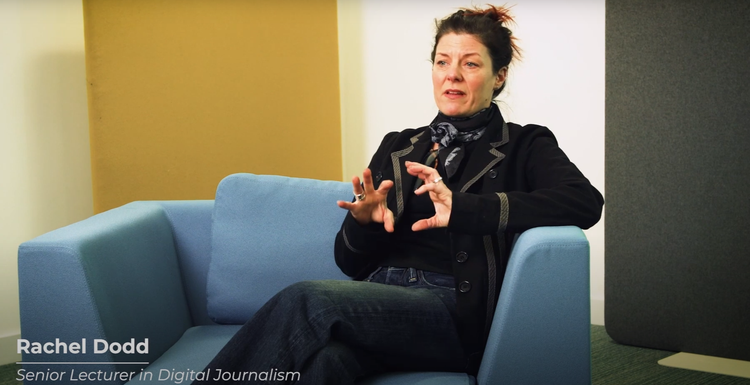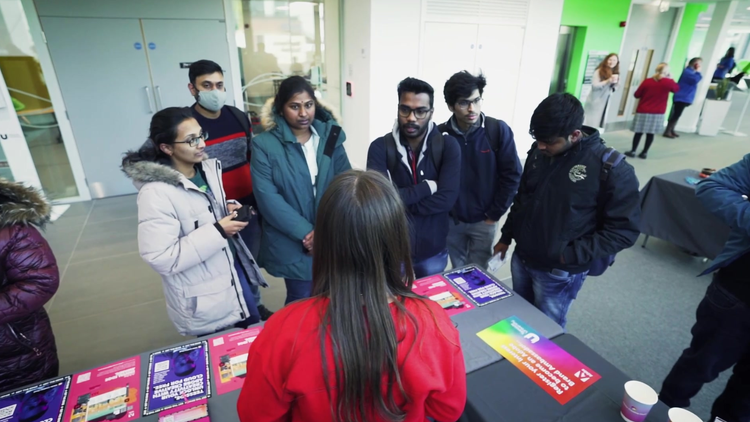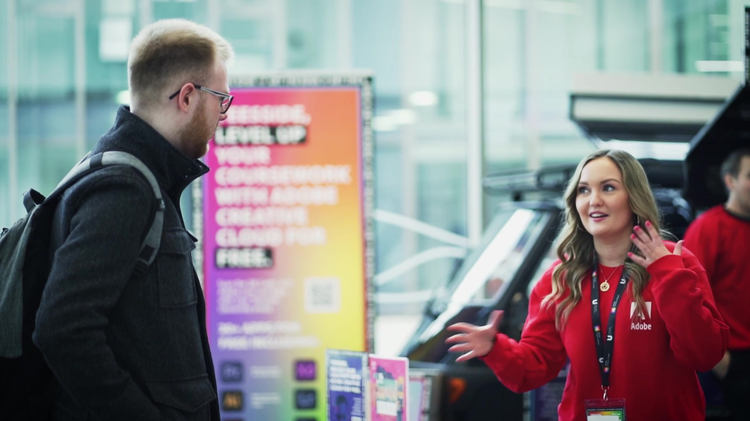At Adobe, we believe all students must be taught essential creative and digital literacy skills that open doors to a brighter future and prepare them to thrive in a changing world. For us and many education institutions across the world, creation is the ultimate expression of learning because when students are empowered to create, they become more engaged and intentional, and better able to grasp concepts and subjects.
Announced in 2020 as the first Adobe Creative Campus in the UK, Teesside University set out to redefine the way academia prepared its students for the modern workforce by giving them free access to creative technology, helping inspire its students to be more collaborative, improve their digital literacy skills, and help them to grow more confident in their skills.
For Senior Lecturer of Digital Journalism at Teesside, Rachel Dodd, this success is down to a shift in mindset from old-school “teaching”, whereby students passively absorb lectures and PowerPoint slides, to a new school of co-learning, whereby students have access to powerful applications including Adobe Creative Cloud, Adobe Express, and Microsoft Teams that allow them to develop new skills first-hand.
By helping students become active creators through hands-on digital projects – like building their own website or growing their online following – they are able to develop higher-order critical thinking and problem-solving skills that enable them to thrive in an increasingly digital world.
“Academia is an intellectual pursuit, but not everyone learns by reading, writing, and repeating what they’ve heard,” says Dodd. “The pedagogy of today accepts that real learning happens while doing, and since becoming an Adobe Creative Campus, we have been proving those findings right.”
https://www.youtube.com/watch?v=VJfhYtpKJ_k
Making education accessible and engaging
The COVID-19 pandemic was a seminal moment for Teesside. With more than 21,000 students suddenly stuck at home as of April 2020, teachers needed to adapt their methodologies and coursework to the realities of digital learning. Dodd led by example, drawing on her previous experience as an architect and designer to transform her lectures and move them to a web environment.
Her initial plan was to get through lockdown, but fast-forward to October 2020, when Teesside had become an Adobe Creative Campus, Dodd was focused on empowering teachers to use technology to engage and inspire their students. Taking the lead once again, Dodd replaced her lectures with webpages created on Adobe Spark – now Adobe Express – allowing students to access learning materials on demand, on any device, and in a more approachable format.
Rather than rehashing old slides from previous years, putting those online, and then forcing students to find and do their complementary reading elsewhere, Dodd pulled everything her students needed together onto a single, user-friendly webpage. She also turned all of her guides around courses, modules, and assessments into an Adobe Express video, which was posted to Facebook so students could watch it on their phones.
“The response from my classes was overwhelmingly positive and proved something most educators have known for years: Learning shouldn’t be convoluted. It should be simple, accessible, and engaging,” says Dodd.
Empowering Students to Create
Dodd is also taking advantage of every Teesside student having free access to Adobe Creative Cloud. Through a pioneering assignment called “Global Brands”, Dodd asked each of her students to create a new brand from scratch using Adobe Illustrator, including a brand identity and a working website.
This was new and exciting territory. For the first time, Dodd’s students got a taste of what it means to create and position a brand, from the basics of storytelling through to the development of a visual concept, and finally to using technology to bring their story to life.
“We didn’t just partner with Adobe to develop new teaching resources. This endeavour is all about empowering students through better ways of learning, and there’s no better way than by encouraging them to explore Adobe’s technologies for themselves,” says Dodd.
The “Global Brands” project was also a testbed for a new approach to project feedback. Students posted their work in a Microsoft Teams chat, where their peers would then review it and share notes. On top of being a healthy way to share constructive feedback between them, it was also more reflective of how creativity is critiqued in the professional world.
What’s more, peer reviews gave students the space to lead their own creative journeys and work more collaboratively. They learn to be vulnerable, which builds their tolerance for uncertainty, and to be more introspective, which breeds self-improvement. In short, Dodd was helping her students to become resilient, work-ready graduates.
“This module has made me go out of my comfort zone to get skills I would have never gone out of my way to acquire,” said one MA student.
While another said the project “made me believe more in my abilities, especially with digital technology such as Adobe Spark and Illustrator.”
The results of “Global Brands” were excellent. Dodd realised she had unintentionally provided students with a formative assessment point to develop their learning through iterative practice. This in turn informed a new delivery approach that embedded a formative assessment process into her “Media Project module and yielded exceptional results. The project had a 100% pass rate, and every single one of Dodd’s students progressed to the next year of their education. What’s more, 80% of them welcomed the new digital delivery model for their coursework.
“I would definitely prefer this model” said one year-two student of the updated Media Project approach. “It’s like floating on a really calm river, gently nudging us along. I wish there was that sort of creative outlet [for all modules].”
A healthy dose of creativity
Two years after becoming an Adobe Creative Campus, Teesside University continues to transform its teaching approach and bring new faculties on board with the programme. Going paperless has also made it easier for staff to coordinate with their colleagues and students.
The goal for teachers like Dodd, who is also the school’s Adobe Creative Campus Lead, is to help students in every field to explore their creativity and improve their digital literacy. In turn, this will prepare them to use digital tools to tackle innovative projects in the workplace find creative solutions to the problems of tomorrow.
“From our business school to our engineering courses, Adobe is helping us to inject a healthy dose of creativity into the Teesside student experience,” says Dodd. “As teachers, it’s on us to take advantage of this opportunity and ensure students graduate with the digital skills they need to succeed in today’s job market.”
Interested in the Adobe Creative Campus programme? Click here to learn more and join leading colleges and universities around the world in the quest to digital literacy in higher education.






